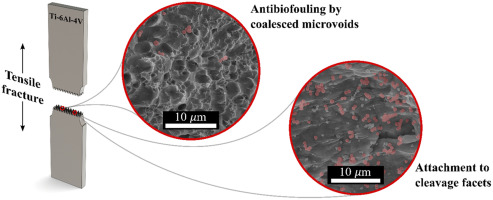Journal of the Mechanical Behavior of Biomedical Materials ( IF 3.9 ) Pub Date : 2018-10-21 , DOI: 10.1016/j.jmbbm.2018.10.020 Amar Velic 1 , Asha Mathew 1 , Peter Hines 2 , Prasad K D V Yarlagadda 1

|
In the biomedical arena, bacterial fouling is a precursor to complications such as implant infection and nosocomial infection. These complications are further compounded by biochemical mechanisms of resistance that threaten the action of traditional antibacterial strategies. Accordingly, antibacterial property by physical, not biochemical, mechanisms of action is becoming increasingly popular and promising. The present work falls in line with this paradigm shift. Here, microtextured Ti-6Al-4V surfaces were manufactured by destructive tension at three different cross-head speeds, probed with scanning electron microscopy (SEM) and multifocus optical microscopy, and treated with Staphylococcus aureus to study bacterial attachment. The fractographic study revealed the presence of dual-mode fracture, typical of Ti-6Al-4V, comprising regions of both ductile, microvoid coalescence and brittle, cleavage faceting. Based on load-extension curves, quantitative roughness data, and qualitative SEM visualisation, it was evident that cross-head speed modulated fracture behaviour such that increased speed produced more brittle fracture whilst lower speeds produced more ductile fracture. The topography associated with ductile fracture was found to possess notable antibiofouling property due to geometric constrains imposed by the coalesced microvoids. Accordingly, fracture at low cross-head speeds (1 mm/min and 10 mm/min) yielded significant reduction in bacterial attachment, whilst fracture at high cross-head speeds (100 mm/min) did not. The greatest reduction (~72%) was achieved at a cross-head speed of 1 mm/min. These findings suggest that antibiofouling property can be elicited by fracture and further ‘tuned’ by fracture speed. Discovery of this novel, albeit simple, avenue for topography-mediated antibacterial property calls for further research into alternate techniques for the manufacture of ‘physical antibacterial surfaces’.
中文翻译:

通过骨折地形控制细菌附着。
在生物医学领域,细菌污染是诸如植入物感染和医院感染等并发症的先兆。这些并发症进一步受到抵抗生化机制的威胁,这些机制威胁着传统抗菌策略的作用。因此,通过物理的而不是生化的作用机理的抗菌性能变得越来越流行和有前途。当前的工作与这种范式转变是一致的。在这里,通过在三种不同的十字头速度下的破坏性张力制造具有微织构的Ti-6Al-4V表面,然后用扫描电子显微镜(SEM)和多焦点光学显微镜进行探测,并用金黄色葡萄球菌进行处理研究细菌附着。形貌学研究表明存在双模式断裂,典型的是Ti-6Al-4V,包括延性,微孔聚结和脆性分裂面的区域。基于载荷-延伸曲线,定量粗糙度数据和定性SEM可视化结果,很明显,十字头速度调节了断裂行为,以至于增加的速度产生更多的脆性断裂,而降低的速度产生更多的延性断裂。由于聚结的微孔所施加的几何约束,发现与韧性断裂相关的形貌具有显着的抗生物污垢特性。因此,在低十字头速度(1 mm / min和10 mm / min)下的断裂导致细菌附着的显着减少,而在高十字头速度(100 mm / min)下的断裂却没有。在1 mm / min的十字头速度下,最大程度的降低(〜72%)。这些发现表明,抗生物结垢特性可以通过断裂产生,并可以通过断裂速度进一步“调整”。发现这种新颖的,尽管简单的,用于地形学介导的抗菌性能的途径,仍需要对制造“物理抗菌表面”的替代技术进行进一步的研究。



























 京公网安备 11010802027423号
京公网安备 11010802027423号